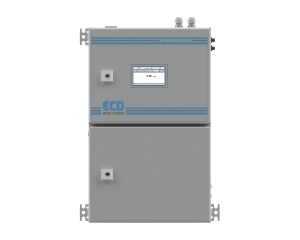Enhancing Wastewater Ammonia Treatment With Economical CA-6 Colorimetric Analyzer
 Anaheim, CA—August 25—2020—Engineers at municipal wastewater treatment plants tasked with the removal of ammonia will find the versatile CA-6 Colorimetric Ammonia Analyzer from Electro-Chemical Devices (ECD) helps them protect water quality with confidence prior to releasing effluent into re-use systems, groundwater recharge basins and surface water systems.
Anaheim, CA—August 25—2020—Engineers at municipal wastewater treatment plants tasked with the removal of ammonia will find the versatile CA-6 Colorimetric Ammonia Analyzer from Electro-Chemical Devices (ECD) helps them protect water quality with confidence prior to releasing effluent into re-use systems, groundwater recharge basins and surface water systems.
Exposure to ammonia over time is toxic to aquatic life. The U.S. Environmental Protection Agency (EPA) recommends a limit of 0.02 ppm as NH3 in freshwater or marine environments. Total ammonia levels, at this limit, can range from 160 ppm at a pH6 level and at temperature of 41°F (5°C) to 0.06 ppm at a pH9 level and temperature of 77°F (25°C).
Wastewater treatment plants frequently use the Nitrification method to remove ammonia. Nitrification is a two-step process for removing ammonia from wastewater using two different types of autotrophic bacteria that oxidize ammonia to nitrite (nitrosomonas) and then oxidize nitrite to nitrate (nitrobacter).
The ECD CA-6 Ammonia Analyzers help plant technicians determine the effectiveness of the treatment process prior to effluent discharge. With its adjustable cycle time, the CA-6 Ammonia Analyzer reduces the cost of treatment by minimizing the use of consumable reagents while still getting the job done effectively. Technician time is reduced as well, freeing staff for other important tasks.
The CA-6 Analyzer is an on-line sequential sampling analyzer. It automatically performs a controlled sequence of sampling, analysis and then results processing is performed and repeated using colorimetric methods with a reagent. The colorimetric method of water analysis relies on an LED light source and a heated colorimetric cell, which has been designed for measuring trace amounts of Ammonia in water.
The versatile CA-6 Colorimetric Analyzer can be configured to measure Ammonia or a wide range of other substances with a choice of multiple parameters: ppb, ppm and mg/L. It measures Ammonia over a wide range from trace 0 to 50 mg/L. Three separate Ammonia measurement ranges are available: 0 to 1.0 mg/L, 0 to 10 mg/L and 0 to 50 mg/L.
The CA-6 Colorimeters make two measurements during an analysis cycle. The first measurement is of the raw sample which sets the base line for the compensation of color, turbidity and optical characteristics of the cell. The second measurement occurs after the color forming reagents have been added to the sample, mixed and adequate time has passed to allow for color formation. The concentration is calculated using the difference between the two absorbance measurements and the stored calibration information in the analyzer.
The CA-6 Colorimetric Analyzer is equipped with a graphic touchscreen interface showing measured values and status information. It provides users with easy access to menus and functions in multiple languages. There is an integrated data logger onboard with USB download capability for history tracking.
The display’s home screen shows the measured parameter, the status, % reagent volumes, time and Menu choices. The on screen HELP menu includes information on Start Up, Shut Down, Start/Stop Commands, Calibration, Function List, Programing, Maintenance and Troubleshoo1ng.
Outputs provided with the CA-6 Analyzer include two 4-20 mA outputs for measured data, and it also includes a Modbus compatible RS485 RTU. Four programmable SPDT relays are available to provide alarm capability.
The CA-6 Colorimetric Analyzers is designed with two compartments that separate critical electronics from the wet process. The standard model is recommended for indoor use and rated NEMA IP54 for dust and water ingress. The operating temperature range of the CA-6 Analyzer is 41 to 113 °F (5 to 45 °C).
